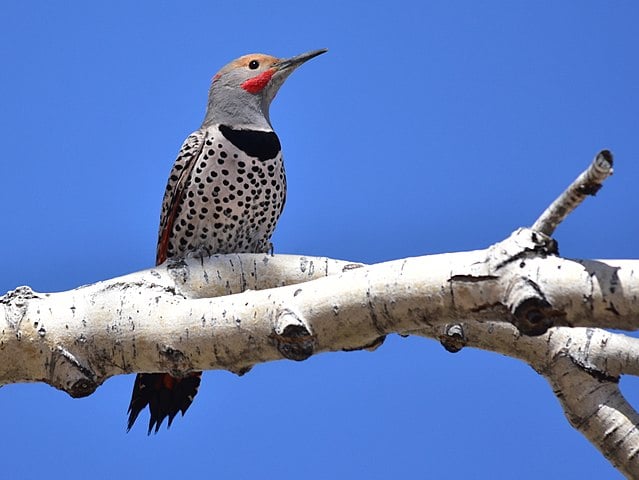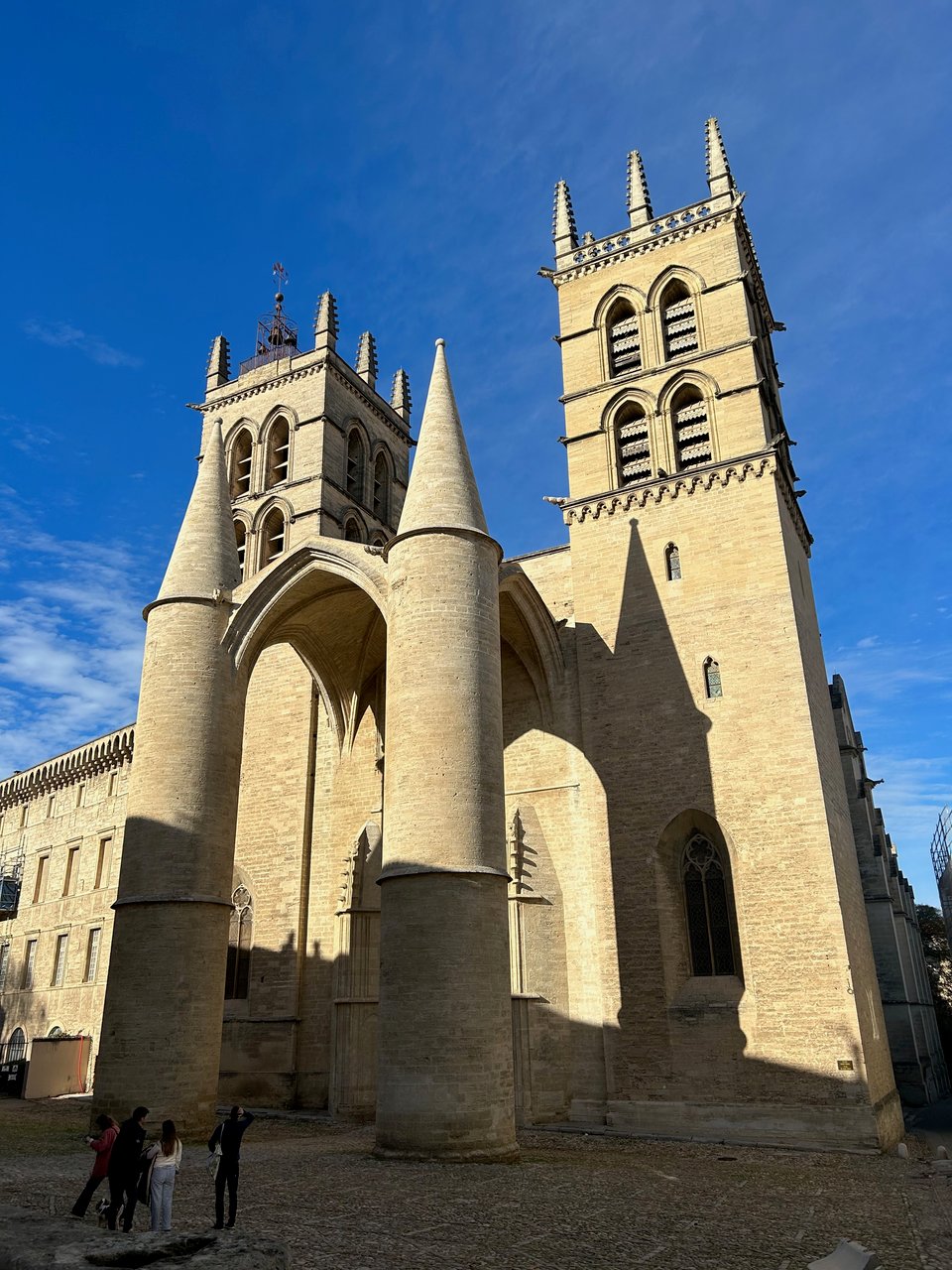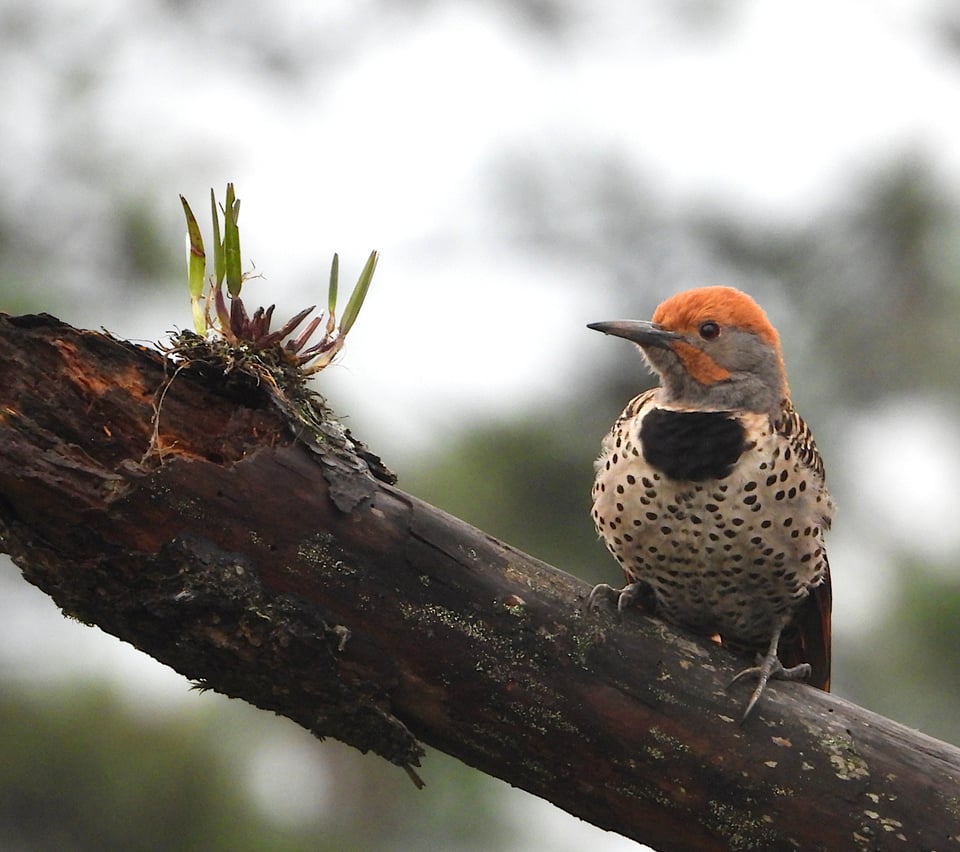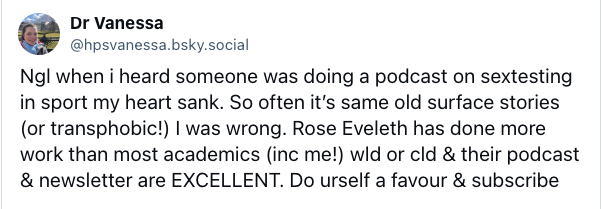TESTED EPISODE SIX: LUMPERS AND SPLITTERS

Episode Six: Lumpers and Splitters
Christine and Max are some of the most recent female athletes in this century-long history to face tests, stigma, and restrictions. But they are unlikely to be the last. In this episode, we find out whether Christine qualifies for the Paris Olympics, as well as the fate of Max’s court case. And we explore the broader implications of the sex binary in sports. Is there a better way for sports to be categorized?
→ → → LISTEN HERE (or wherever you get podcasts) ← ← ←
This is the final episode of Tested, but this topic is still very much alive. And this newsletter will continue to cover this area. There is news brewing, that I’ll be able to bring you here. And you’ll also get a lot of additional essays, thoughts, and material that we couldn’t fit into the show itself.
Today, I fly to Paris to go see some of the athletics on the track at the Olympics. So soon you’ll get a little recap of that in this newsletter! Wish me luck, my French is (as you probably know, if you listened to the podcast) terrible.

CUTTING ROOM FLOOR: Athletes, Far and Wide
Over the course of reporting this series, I spoke with a bunch of athletes. Some on the record, some off. You don’t hear all of them on the show. This is one of the hardest parts of being a reporter — talking to people, and then not using their tape because it doesn’t fit in the story. So I want to tell you a bit more about two of these athletes here:
In France, I visited Aminatou Seyni. You hear a tiny bit of her in episode six, but I spent a whole day with her. Amina lives in a small dorm room next to the track. She has a Nigerien flag hung up, and a small stack of clothes (all Nike, her sponsor) but not much else. She eats her meals at the small cafeteria on the campus, and spends most of her day either training, or on her phone, chatting with friends and family from home. Training is her life. It’s all she does. While I was there, she was running next to high school students who almost certainly had no idea they were doing forced PE laps next to one of the fastest women in the world.
She told me that when she gets lonely or sad, she watches short YouTube educational videos from Niger. It’s interesting, a lot of the athletes I spoke with are deeply homesick and also quite critical of their home country. Amina had a lot to say about how closed minded people in Niger are. And she’s experienced it first hand.
One story she told me that stuck with me, was when I asked her to about the first big race she ever won. She says that it was a longer distance race — a 3,000. She ran away with the race, but instead of being celebrated, chaos broke out. The people in the stadium started shouting and complaining. The Nigerian Federation wouldn’t give her her trophy for winning. She told me that people started swarming the small office at the track, where she was waiting, and the military had to come and escort her away because people wanted to hurt her. When I asked why these people wanted to hurt her, she told me that they believed that she was a man who had entered the women’s competition.
You can see Amina interviewed here, here and here. Special thanks to Rozena Crossman, who served as my interpreter for my interview with Amina.

Another athlete I spoke with was Evangeline Makena. We met up at a park outside Nairobi where she goes to relax. Eva is soft-spoken and quite shy. She told me that this whole thing was just… confusing for her. She didn’t understand it. She couldn’t understand what people were saying about her, that she was different, that she wasn’t like the other women. She also told me that it’s really hard to train hard when you know that the rules can change at any time. You can see Eva in the documentary Category: Woman.
You hear from Annet Negesa in the series a bit as well, but she’s another athlete I spent hours with and only used a tiny clip of. I flew to Germany to see her back in 2022, when I was still funding the reporting of this show out of my own pocket. Her story is featured in Category Woman as well, and in this Human Rights Watch Report. You can also read her story as written by Annet herself here.
There are a few other women I spoke with by text, off the record, who didn’t want to be named or interviewed on tape. Thank you, to those women, who helped me understand things better.
I don’t take it lightly, that these women let me tell their stories. These are people who have been picked apart by the media. Every time they agree to speak with a journalist, it opens up new scrutiny. People online think that it’s somehow an invitation to discuss their bodies, how they look, who they really are. I’m not sure I would talk to the media, if I were them. And so I’m really, really grateful for their time and willingness to speak to me.
You’ll notice that I don’t really have any photos of the women themselves in this newsletter. That’s not only because I’m a terrible photographer and always forget to take pictures of things I’m doing. It’s also because when I was first chatting with these women, asking them to speak with me, I promised them that this was an audio only project. I take that promise really seriously. You can find their social media pages to see how they want to present themselves — or watch their races to see them performing at their sport. You don’t need pictures of them from me, in this newsletter.
If you want to follow the women you heard about on Tested:
FLICKERS, FLICKERS, EVERYWHERE

At the very end of the show, you hear about a bird called a Northern Flicker.
John J. Audubon wrote this about the Northern Flicker (which he called the Golden-winged Woodpecker):
It is generally agreeable to be in the company of individuals who are naturally animated and pleasant. For this reason, nothing can be more gratifying than the society of Woodpeckers in the forests. To prove this to you, kind reader, I shall give you a full account of the habits of the Golden-winged Woodpecker.
It’s kind of amazing how hard these birds can be to see given how big and striking their coloration is. They also have a very iconic call — often you hear them before you see them. I had to seek the help of my expert birding friend (Ed Yong, a celebrity cameo at the end of episode six) to help me find out.

Also! Breaking news on the flicker front: in the episode we talk about how the Northern Flicker was lumped back into one species. But it has been split again! Not to combine the red and yellow forms, those are still one species. But there is another bird in Guatemala that has been split off into its own species! The Guatemalan Flicker (Colaptes mexicanoides) is now its own thing. Here’s what a recent American Birding Association update says:
This may not be the split you were expecting. It doesn’t have anything to do with red- vs. yellow-shafted birds, but rather, rusty- vs. gray-naped birds. Compared to “Red-shafted” Flickers, birds south of the Isthmus of Tehuantepec (Guatemalan Flickers) have rusty crowns and napes. Females differ further by always having bold rusty “moustaches”; note that some female “Red-shafteds” have a comparatively subtle buffy moustache. And there are vocal differences; for instance, Guatemalan Flicker lacks the strident, downslurred KLEER! call so familiar to many of us from the ABA Area.
Here’s a picture of the Guatemalan Flicker:

Other places you can hear me, or other people, talking about Tested:
I talked to Christen at Unladylike.
Was so chuffed to be Linda Holmes’s “What’s Making Me Happy” pick last week on Pop Culture Happy Hour.
I answered a few questions for the Teen Health Today newsletter.
I talked to Scientific American’s podcast Science Quickly about the show.
If you’re an NPR listener, keep your ears open for a segment from Tested on All Things Considered!

If you want to learn more about anything that we talked about on this show, we made a special curated guide to books, papers, documentaries, podcasts, and more that will give you a deeper look. And, as always, each episode has a transcript online with citations and footnotes.
THE ART!!!
One more huge round of applause for Dani Pendergast, who made episode specific art for NPR for this show. Look how incredible they all look together.

I don’t honestly know how to wrap up this edition of the newsletter. I’ve been working on this series for so long, so it’s surreal for it to be over (in podcast form, at least). Thank you for listening, for sharing, and for going on this journey with me. I hope you enjoyed it, and that it made you think about the world a little differently.
As I said at the top, this newsletter will continue on offering updates, essays, and more.
Onward and upward,
Rose